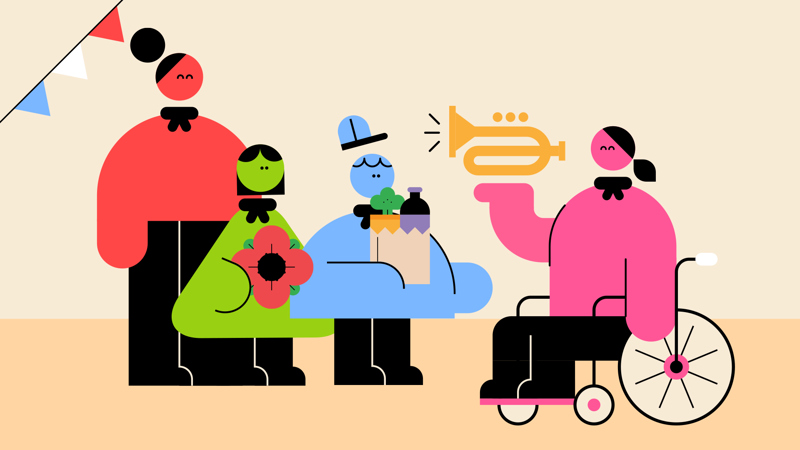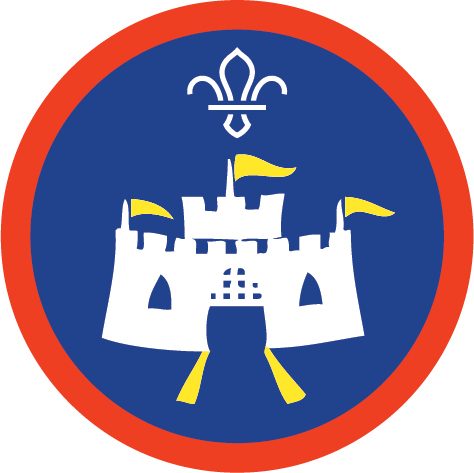
VE prepared
You’ll need
- Scissors
- Plates
- Knives
- Forks
- Device to play music
- A4 coloured paper
- Firelighting materials or access to a kitchen
- Get creative at home. Instead of decorating your meeting place, encourage your group to decorate wherever they are dialling in from. Blue, red and white are the colour themes, but people can use whatever materials they have to hand – just as they did in 1945!
- Dial in with style. Why not decorate the space behind you to create a themed backdrop for when you call into your online meeting? You could also wear something red, white or blue to mark the occasion.
- Share your snacks. Whilst it might not be easy to have a shared dining experience, you could bring along your favourite snacks to the online meeting and virtually share them with everyone by describing their taste, why you like them and any fun facts about them.
- Reflect. Take time to share thoughts, ideas and feelings at the end of your digital meeting, just as you would if you were bringing in-person celebrations to a close.
For more information, check out our guidance on how to continue Scouting at Home or browse other activities that work indoors and online.
Before you begin
- This activity is all about remembering VE Day (Victory in Europe Day) and the role that Scouts played. We’ve included plenty of suggestions, and it’s up to you which you include.
- VE Day was all about community, so why not use this chance to invite your local community to celebrate with you, and see what Scouts is about?
Wait, what’s VE Day?
VE Day marks the day towards the end of the second world war when fighting against Nazi Germany came to an end in Europe – 8 May 1945. The Prime Minister at the time, Winston Churchill, declared a national holiday that led to a day of partying and celebrating. This activity is all about celebrating like it’s 1945!
Decorate
The Union Flag was flown high as a sign of peace and victory in Europe. Across the UK, people used red, white, and blue decorations to celebrate – they’re the colours of the Union Flag, and were also the colours of the Allied countries in the second world war.
- Everyone should get red, white, and blue paper (or fabric).
- Everyone should cut triangles from their material. They should be isosceles triangles – they should have a fairly short base and two longer, equal, sloping sides.
It doesn’t matter if the triangles aren’t perfect or if the material’s a bit mismatched. In 1945, people rushed to create decorations as fast as they could, often without a lot of money or materials. Within a few hours, makeshift flags and bunting began to pop up across the UK.
- Everyone should attach their triangles to a piece of string (or a strip of fabric). Depending on what they’re using, it might work best to use a glue stick, staples, or needle and thread.
- Everyone should work together to hang the bunting. They should avoid heaters, vents, and lights!
- Everyone should get creative with any leftover materials. They could make hats, badges, or table decorations, for example.
Sounds of victory
Music was a big part of VE day. Some people used gramophones, instruments, and barrel organs, others just sang their own songs.
- Everyone should listen to some music from the time. Popular artists from the second world war include Ella Fitzgerald, The Andrews Sisters, Vera Lynn, and Benny Goodman.
- Everyone should think about which of the songs they like best. Could they make a playlist?
- People could think about how they might dance to the music. They could look at popular dances in the 1940s including the jive, jitterbug, and swing dancing for inspiration.
VE Day dining
On VE Day, communities up and down the country set up tables and chairs in the street and shared food to celebrate together. You could encourage everyone to bring a different dish, or you could cook up a range of things together. You could even look up VE Day recipes – because of rationing, there were many makeshift versions of familiar dishes, such as cakes that didn’t use eggs or sugar.
As always, be mindful of dietary requirements and allergies – you may need to avoid some allergens altogether, and everything should be clearly labelled.
- Everyone should work together to set out tables and chairs in long rows. They should decorate them with red, white, and blue decorations. They could even use flowers!
- Everyone should lay out the food and make sure everything’s clearly labelled.
Food and other everyday items were rationed during the war. For VE Day, certain items like ice cream were available as a special treat.
- Everyone should enjoy their VE Day dining. How do they think it would’ve felt to enjoy food after such a long time of rationing?
Skilled Scouts
It’s up to you how you reflect on the role Scouts and Guides played in the second world war. You could gather around a fire (and perhaps make a treat like s’mores). Bonfires had been banned during the second world war, so on VE Day people lit fires to celebrate the end of the war in Europe.
- Everyone should think about how the second world war affected Scouts and Guides. People might think about how it affected communities all over the UK – more than half of leaders were called up to fight in the war, and lots of Scouts and Guides were evacuated (many children living in big cities and towns temporarily moved to safer places, usually in the countryside).
- The person leading the activity should explain some of the ways Scouts and Guides helped on the home front.
We’ve included some information below. You can find out more about what Scouts got up to in the second world war with this exhibition from the Heritage Service.
- Everyone should think about the skills the Scouts and Guides used. Do Scouts and Guides have any of the same skills today? How could people use their skills to help out their local area right now?
- Everyone could get a blanket badge to celebrate the anniversary of VE Day.
How did Scouts help in the second world war?
Scouts helped to collect waste paper (over one million tonnes were recycled over the war) as well as metal, rubber, and rags. They also played a really important role by welcoming displaced persons and refugees from Europe at train stations and in their towns and villages. The UK welcomed 10,000 children and more than 70,000 Jewish refugees over the course of the war.
Scouts helped as part of the Air Raid Precautions (ARP) by issuing and fitting gas marks, building shelters, acting as Air Raid Wardens, firefighting, guiding people to public shelters, and saving people from some of the two million homes that were destroyed by bombing raids.
Reflection
This activity was about being a citizen. How were Scouts and Guides citizens in the second world war? People might remember some of the ways they helped. How did Scouts use the skills they had? Why is it important to remember events like the second world war (and VE Day)? It’s important to remember important historical events, and the people who made sacrifices, but also to remember the impact the war had on people at home and how they worked together to help out. Right now, there’s no war, home front, or rationing… but there are still plenty of people and causes that need help. What impact could the group have in their local area? If people need inspiration, A Million Hands is a great place to start.
This activity was also about building friendships. Does sharing celebrations help people feel connected to each other? How might friendships have been important during the second world war? People might think about how friends help one another and listen to people’s worries. How can people use anniversaries like VE day to reach out to others in their community?
Safety
All activities must be safely managed. You must complete a thorough risk assessment and take appropriate steps to reduce risk. Use the safety checklist to help you plan and risk assess your activity. Always get approval for the activity, and have suitable supervision and an InTouch process.
- Cooking
Teach young people how to use cooking equipment safely. Supervise them appropriately throughout. Make sure it’s safe to use and follow manufacturers’ guidelines for use.
- Fires and stoves
Make sure anyone using fires and stoves is doing so safely. Check that the equipment and area are suitable and have plenty of ventilation. Follow the gas safety guidance. Have a safe way to extinguish the fire in an emergency.
- Food
Remember to check for allergies, eating problems, fasting or dietary requirements and adjust the recipe as needed. Make sure you’ve suitable areas for storing and preparing food and avoid cross contamination of different foods. Take a look at our guidance on food safety and hygiene.
- Scissors
Supervise young people appropriately when they’re using scissors. Store all sharp objects securely, out of the reach of young people.
- Music and films
Make sure music and films are age appropriate for the youngest person present.
See if anyone in your community can pass on stories or information about the impact of the second world war in your area.
Make sure you cater for everyone’s dietary requirements. Adapt the dancing so everyone can take part.
All Scout activities should be inclusive and accessible.
Do some more research about what VE Day was like in your area. If you search for VE Day and the name of your area, you may even find some events planned to mark its anniversary.

